Renewable is not Sustainable
The electricity industry has embraced the cause of renewable energy sources, primarily wind and sun, so that it can pour gallons of greenwash over its installations and run TV commercials about how it’s helping to save the planet. But the industrialization of renewable energy sources is little more sustainable than are fossil-fuel-burning plants.
For example: dozens and dozens of multi-billion-dollar solar projects haven been proposed for the desert southwest, where, of course, there is lots of sunshine. But most of the proposals involve using the concentrated heat from the sun to run boilers. A typical proposal, for Amargosa Valley, Nevada, would require 1.3 billion gallons of water per year. Water, as you may know, is not plentiful in deserts.
[“Alternative Energy Projects Stumble on a Need for Water” — The New York Times.]
(It is not widely recognized how thirsty the electricity generating industry is. Providing power to the typical American home requires three times as much water as the household consumes for all other purposes.)
There are many other difficulties attending desert solar plants. You need water, as well, for the hundreds of people needed to build and maintain the plants. You need to build huge transmission lines through thousands of back yards to get the power thus produced to market.
As with solar, the industrial approach to wind energy is to erect giant wind turbines where there is lots of wind and transmit it to market via the grid. First, nothing that requires the manufacture of enormous machines and the erection of huge installations can be regarded as sustainable. Second, the highly variable output of wind turbines poses some extremely difficult problems for the managers of the grid.
What would be both renewable and sustainable when it comes to energy? The answer is simple, though not easy. We have to start, right now, to produce the energy we need where we need it. We need, in other words, to de-industrialize electricity, if we are going to keep on having any.
[For much more on this see also Chapter Six, “Grid Lock,” of my book Brace for Impact now available.]
The electricity industry has embraced the cause of renewable energy sources, primarily wind and sun, so that it can pour gallons of greenwash over its installations and run TV commercials about how it’s helping to save the planet. But the industrialization of renewable energy sources is little more sustainable than are fossil-fuel-burning plants. Continue reading →

